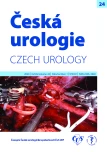Multi-resistant gram negative bacteria in urology
Authors:
Vanda Adamcová 1; Lucie Bartáková 1; Pavel Čermák 2; Roman Zachoval 1,3; Jan Hrbáček 1
Authors‘ workplace:
Urologická klinika 3. LF UK a Thomayerovy nemocnice, Praha
1; Oddělení klinické mikrobiologie, Thomayerova nemocnice, Praha
2; Urologická klinika 1. LF UK, Praha
3
Published in:
Ces Urol 2020; 24(1): 18-25
Category:
Review article
Overview
Gram-negative bacteria are the most com ‑ mon pathogens causing urinary tract infections. The incidence of bacterial resistance is increasing worldwide. Prevention and treatment of infections caused by resistant bacteria are becoming a vast medical, social and financial problem. The biggest problems are health care-associated infections and infections related to invasive lines. Knowledge of resistance mechanisms and local epidemiological situation help with effective initiation of empirical antibiotic therapy
Keywords:
resistance – Urological infection – gram-negative bacteria – antibiotics
Sources
1. Rottier WC, Ammerlaan HSM, Bonten MJM. Effects of confounders and intermediates on the association of bacteraemia caused by extended‑spectrum β‑lactamase‑producing Enterobacteriaceae and patient outcome: a meta‑analysis. J Antimicrob Chemother. 2012; 67(6): 1311–1320. 2. Magyar A, Köves B, Nagy K, et al. Spectrum and antibiotic resistance of uropathogens between 2004 and 2015 in a tertiary care hospital in Hungary. J Med Microbiol. 2017; 66(6): 788–797. 3. Jawetz E, Brooks G, Melnick J, et al. Jawetz, Melnick, & Adelberg’s medical microbiology. 27th ed. New York: McGraw‑Hill Medical 2016 : 231–236. 4. Page C. Integrated pharmacology. 3rd ed. [Edinburgh]: Elsevier Mosby; 2006 : 113–118. 5. Munita JM, Arias CA. Mechanisms of Antibiotic Resistance. Microbiol Spectr [Internet]. duben 2016 [citován 31. říjen 2018]; 4(2). Dostupné z: https://www.ncbi.nlm.nih.gov/pmc/articles/PMC4888801/. 6. Varga M, Pantůček R, Růžičková V, Doškař J. Molecular characterization of a new efficiently trans ‑ ducing bacteriophage identified in meticillin‑resistant Staphylococcus aureus. J Gen Virol. 2016; 97(1): 258–268. 7. European Centre for Disease Prevention and Control. Surveillance of antimicrobial resistance in Europe 2016. Annual Report of the European Antimicrobial Resistance Surveillance Network (EARS‑Net). Stockholm: ECDC; 2017. 8. Gohel K, Jojera A, Soni S, et al. Bacteriological Profile and Drug Resistance Patterns of Blood Culture Isolates in a Tertiary Care Nephrourology Teaching Institute. BioMed Res Int. 2014; 2014 : 1–5. 9. Medina‑Polo J, Sopeña‑Sutil R, Benítez‑Sala R, et al. Prospective study analyzing risk factors and cha ‑ racteristics of healthcare‑associated infections in a Urology ward. Investig Clin Urol. 2017; 58(1): 61. 10. Toner L, Papa N, Aliyu SH, et al. Extended‑spectrum beta‑lactamase‑producing Enterobacteriaceae in hospital urinary tract infections: incidence and antibiotic susceptibility profile over 9 years. World J Urol. 2016; 34(7): 1031–1037. 11. Ozgur BC, Ekıcı M, Yuceturk CN, Bayrak O. Bacterial colonization of double J stents and bacteriuria frequency. Kaohsiung J Med Sci. 2013; 29(12): 658–661. 12. Kehinde EO, Rotimi VO, Al‑Hunayan A, et al. Bacteriology of urinary tract infection associated with indwelling J ureteral stents. J Endourol. 2004; 18(9): 891–896. 13. Lojanapiwat B. Colonization of internal ureteral stent and bacteriuria. World J Urol. 2006; 24(6): 681–683.
14. Lara‑Isla A, Medina‑Polo J, Alonso‑Isa M, et al. Urinary Infections in Patients with Catheters in the Upper Urinary Tract: Microbiological Study. Urol Int. 2017; 98(4): 442–448. 15. van der Donk CFM, Beisser PS, Hoogkamp‑Korstanje JAA, et al. A 12 year (1998-2009) antibiotic resistance surveillance of Klebsiella pneumoniae collected from intensive care and urology patients in 14 Dutch hospitals. J Antimicrob Chemother. 2011; 66(4): 855–858. 16. Stapleton PJ, Lundon DJ, McWade R, et al. Antibiotic resistance patterns of Escherichia coli urinary isolates and comparison with antibiotic consumption data over 10 years, 2005–2014. Ir J Med Sci. 2017; 186(3): 733–741. 17. Hanuš M, Matoušková M, Králová V, et al. Imunostimulace polybakteriálním lyzátem (Urivac®) v pre ‑ venci recidivujících infekcí dolních močových cest. Ces Urol 2015; 19(1): 33–43. 18. Cai T, Mazzoli S, Lanzafame P, et al. Asymptomatic Bacteriuria in Clinical Urological Practice: Preope ‑ rative Control of Bacteriuria and Management of Recurrent UTI. Pathogens. 2016; 5(1): 4. 19. EAU Guidelines. Edn. presented at the EAU Annual Congress Copenhagen 2018. ISBN 978-94-92671-01-1. 20. Sousa R, Muñoz‑Mahamud E, Quayle J, et al. Is Asymptomatic Bacteriuria a Risk Factor for Prosthetic Joint Infection? Clin Infect Dis Off Publ Infect Dis Soc Am. 2014; 59(1): 41–47. 21. Concia E, Azzini AM. Aetiology and antibiotic resistance issues regarding urological procedures. J Chemother. 2014; 26(Suppl 1): S14–23. 22. Wullt B, Sundén F, Grabe M. Asymptomatic Bacteriuria is Harmless and Even Protective: Don’t Treat if You Don’t Have a Very Specific Reason. Eur Urol Focus. 2019; 5(1): 15–16. 23. Köves B. Asymptomatic Bacteriuria: To Treat or Not To Treat. Pro Treatment. Eur Urol Focus 2019; 5(1): 13–14. 24. Holý O, Matoušková I, Zatloukalová S, et al. Prevalence of strains of Staphylococcus epidermidis and other coagulase‑negative staphylococci with biofilm‑forming ability at a department of hemato‑oncology. Klin Mikrobiol Infekcni Lek. 2018; 24(3): 68–72.
Labels
Paediatric urologist Nephrology UrologyArticle was published in
Czech Urology

2020 Issue 1
Most read in this issue
- Our experience with MRI/TRUS software fusion for targeted prostate biopsies
- Multi-resistant gram negative bacteria in urology
- Hereditary renal cell carcinoma syndromes
- Case report of a gigantic recurrent angiomyolipoma in a horseshoe kidney
